- story – 10 min read
- VIDEO – 36 min watch
- AUDIO – 36 min listen
Designing for a (healthy) global conversation: How Twitter does content strategy

Listen to Twitter’s story or read the transcript below
WRITER is the full-stack generative AI platform for enterprises. We make it easy for organizations to adopt AI apps and workflows that deliver quantifiable ROI quickly.
WRITER helps organizations build highly-customized AI apps that compress entire business processes, support complex use cases, and infuse work with company intelligence. Our enterprise-grade platform can be deployed flexibly, keeps your data private, and adheres to global privacy laws and security standards. Leading enterprises choose WRITER, including Vanguard, Intuit, Accenture, and Kenvue.
Jordan Craig leads Twitter’s content strategy team of more than a dozen people, and Lisa Jennings Young, the third content strategist to join Twitter, is a manager on Jordan’s team. Over the past three years, the content strategy team at Twitter has grown from an editorial function to encompass critical product decisions impacting the health and safety of the Twitter platform. Lisa is part of the team redesigning warning labels for misleading Tweets in an attempt to make the labels more useful and easier to spot. Read or watch the story of how Jordan and Lisa do content strategy at Twitter, the home of our global online conversation, and how WRITER helps them achieve their goals.
First, some context. How Twitter thinks about content strategy:
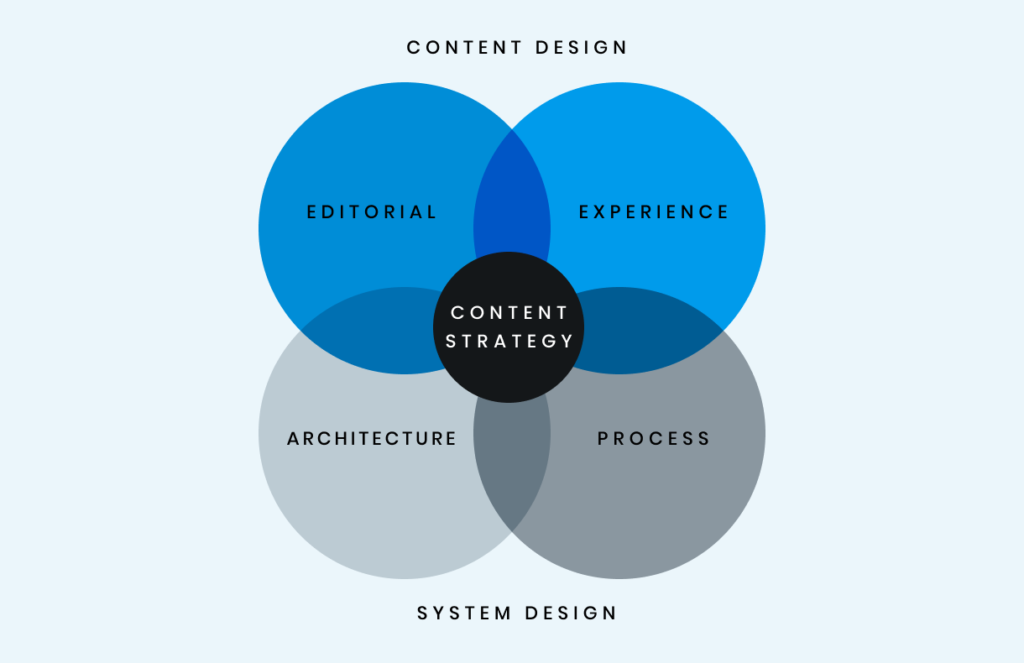
The Twitter content strategy team uses WRITER to:
- Build and host their content style guide
- Manage the Twitter taxonomy and workflow around changing/retiring terms they use in Twitter products or features
- Help everyone at Twitter write well, for both internal communication and user-facing product and support content
How Twitter uses WRITER for scale
Since I joined the team, we really started to lean heavily on a unified project list. If we were trying to take on everything, we’d go back to feeling really stretched. I think that’s one of the places that WRITER helped us out the most, was figuring out how to scale the words that we’re writing and also giving our partners and our peers within Twitter an ability to write on our behalf because we can’t write all of the content.
“WRITER has given us this single source of truth where we can allow people to use WRITER and write the way that we prefer to sound and follow all of our rules within our style guide.”
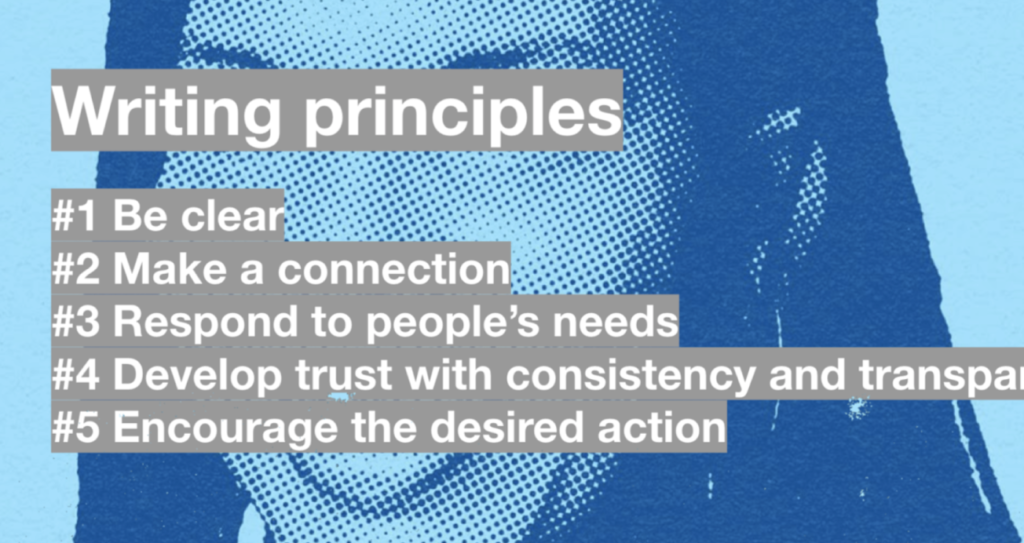
So we’ve worked to get our style guide built in WRITER on our intranet. And we’ve built out not only the style guide, but our terminology. It used to be in a Google spreadsheet.
We’re bringing it into WRITER so that not only do people have it as a reference, if they want to access the style guide, but they can install the WRITER extension and get that real-time feedback.
People are really excited that we have this. The legal team is especially excited because they have a system of record for the language that we can and can’t use. And they can have a historical record of what happens.
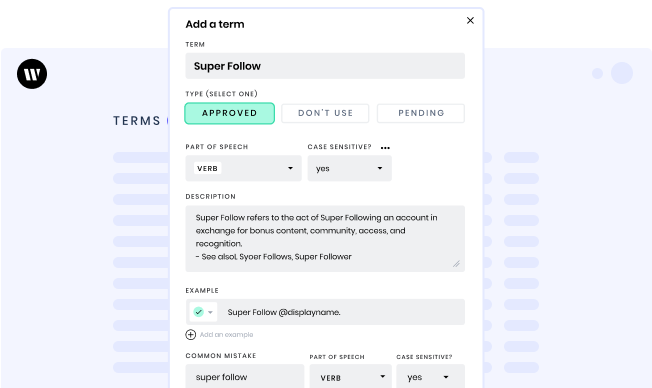
We have different style guides within Twitter. So within content design, we have our style guide, but then the brand team also has their style guide and their voice guidelines, and they need to be cousins. They’re definitely not twins. But they do need to be familial so that when we are talking to people, they don’t have a chaotic experience because the company voice is one way and the content design voice is another.
So it’s been really monumental for us to have a single source of truth in WRITER and for people to be able to give us feedback on the guidelines. And we’re also able to give them automated feedback on their writing, too.
We can work a lot faster. It used to be where we had to re-litigate every editorial decision because we didn’t have a single source of truth. Now with WRITER, we can share that with people in advance. And for example, in the voice section, I’m including a rationale backgrounder, which is from research insights. So people understand why we’re doing the things we’re doing. And not only do we not have to answer a lot of questions or justify decisions, as Jordan said, the stuff is there. And so if people want to work ahead, to write on their own in prototypes or in mocks, it’s there for them. So they can work faster, too.
How Twitter does terminology governance
We just launched a new terminology governance committee. We used to store our Twitter dictionary in a spreadsheet. But now with WRITER, and the ability to put those terms into the platform so people get suggestions as they write, has been huge, so we designed a whole process around how we review terms and who approves them. So we can quickly get new terms out into WRITER and into people’s suggestions as they write.
We also deprecate words that we no longer think are appropriate to use, like whitelist, blacklist, master/slave, et cetera, and really provide those real-time wording replacements immediately. So people aren’t searching for what to replace it with. A style guide is only as good as how up-to-date it is and how easy it is for people to find and use. With WRITER, we can make it available. I can make changes and instantly get them out on our internal website and also have it in people’s WRITER browser extension. So they get those real-time suggestions.
People have so much to say internally at Twitter about the definitions of words versus what something else means.
“Health” refers to the aspect of Twitter’s product that encourages civil discourse and discourages bullying and disinformation.
It’s funny to me to see people be so invested in the terminology because it’s something that I didn’t think anyone would really care about, which I know is ironic since we deal in words. So that’s been a real joy to try it out. People have opinions, for sure. In fact, in the Health area where we’re going to have to set up another cross-functional group to review some of the terms. Because you have people wanting to define them based on their subject matter expertise, whether it’s engineering or policy.
With WRITER, I love the ability to work with all of our cross-functional partners on our terminology management. We have literally someone represented from legal, brand, comms, product marketing, design, and research because everyone’s opinions matter here. WRITER gives us all an opportunity to come to agreement on the words we want to use at Twitter, because words matter.
One of the things that really builds trust on a platform is consistency. One of my sons does rock climbing, right? And you have those climbing holds that you go up and they’re color-coded as you go up the climbing wall.
But if one of those holds is missing or it’s marked as a different color, you could just easily fall down the wall and words are like that. When we do research, we see how customers use those words as a climbing hold to get to the top of whatever task it is they’re trying to do.
So consistency is super important for building trust and helping you just take that correct action quickly.
Healthy conversations about healthy conversations
One of our priorities for content strategy is writing for healthy conversations. Take the Safety Mode feature, which is like an auto block or a smart block. So if we detect harmful or abusive replies to a tweet that you put out, we will give you a notification. And you can turn on this feature which will automatically block accounts that are being mean. And that takes a lot of stress off people.
It’s really important for us to get the voice for the feature correct because that’s when someone is typically dealing with abuse or toxicity and they’re in a really sensitive state.
Luckily, we have this amazing research team as well as the data science team and those insights come back, and it’s pretty clear that those words matter. I’ve seen a huge difference from when I started. People at Twitter understand that now. And people will come to me and say the words matter. We want to get this right. We want to get you involved early so we can test. And so I think there’s a greater awareness of that at Twitter.
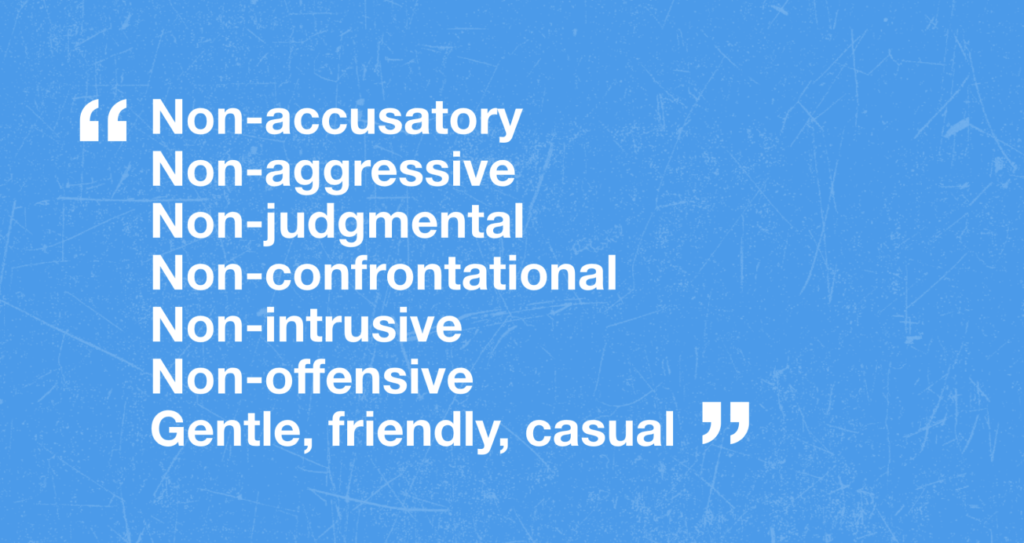
Writing for the article nudge feature
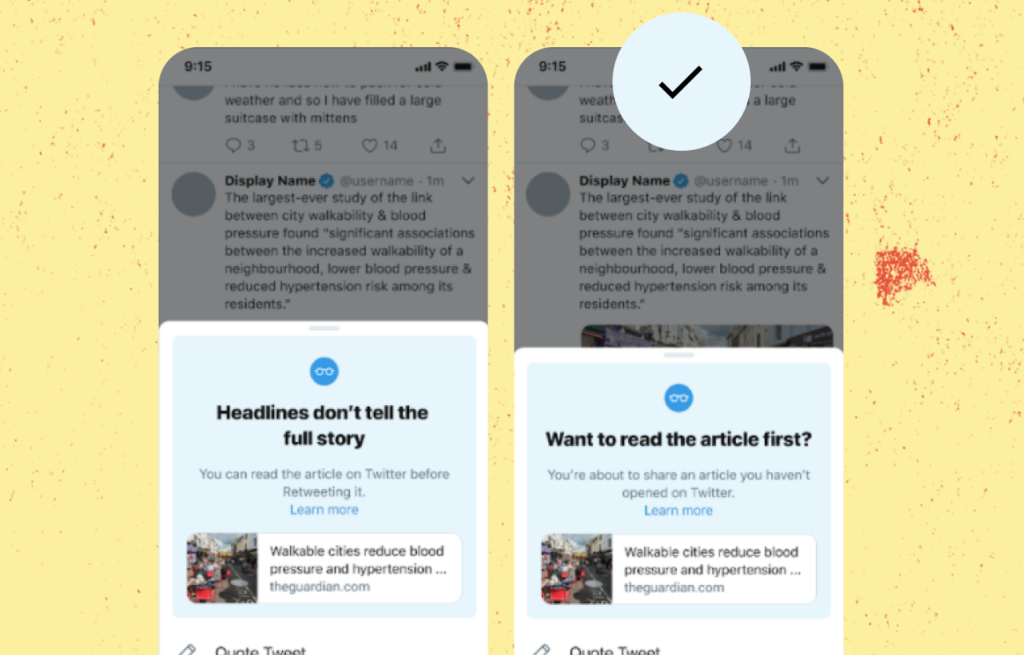
For the first round of [writing for the article nudge feature], we didn’t have a framework for voice for Health. When we started on it, you know, the collective thinking was we wanted to be playful and “Twittery” with our language—kind of amp that up. So we had one that was a little more opinionated and it was, “Headlines don’t tell the full story.” They all tested about the same in quantitative research. We went to market and did a first release with the “full story” headline. And a lot of people really didn’t like it.
We got a lot more feedback and ended up going with “Want to read the article first?” So what I learned from that is that quantitative data is not enough, right? Understanding your business goals for one is super important. And [our goal for this feature was] Twitter’s part needs to be really unbiased.
So it was a process where we learned a ton. Those learnings are now the foundation of what will be our voice for our Health work.
We all joke that people don’t read, but in reality, the article nudge worked quite well. And it really reduced people from just re-tweeting things or tweeting things without actually reading what they were getting ready to repost. We definitely had a goal in mind for how much we wanted the new nudge to reduce the retweet rate, and we blew that goal out of the water. Like it was shocking at how great the article nudge really worked.
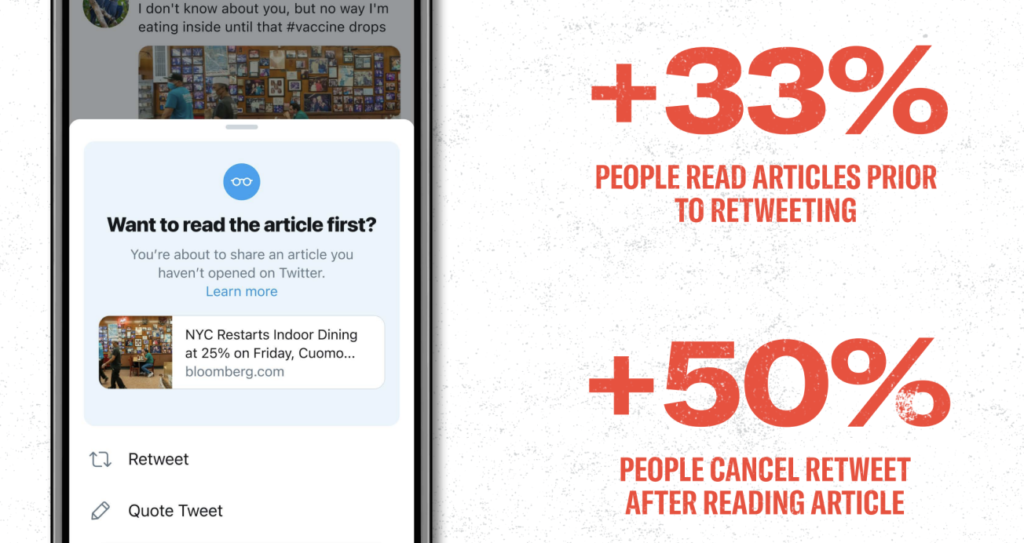
We started to apply some of the same thinking regarding the way we talk to people on the app [to other features]. I think it’s really opened our eyes to how people don’t want to accidentally break the rules and it’s really on us to teach them the right way. And so if we can get them to slow down or pause or just really think it through, it has changed behavior in ways we’ve wanted it to.
When words matter
Words matter, especially for Twitter’s misinformation feature, which lets users know when they’re reading controversial tweets. In the research phase, “Stay informed” and “Misleading” tested better than “Disputed.”
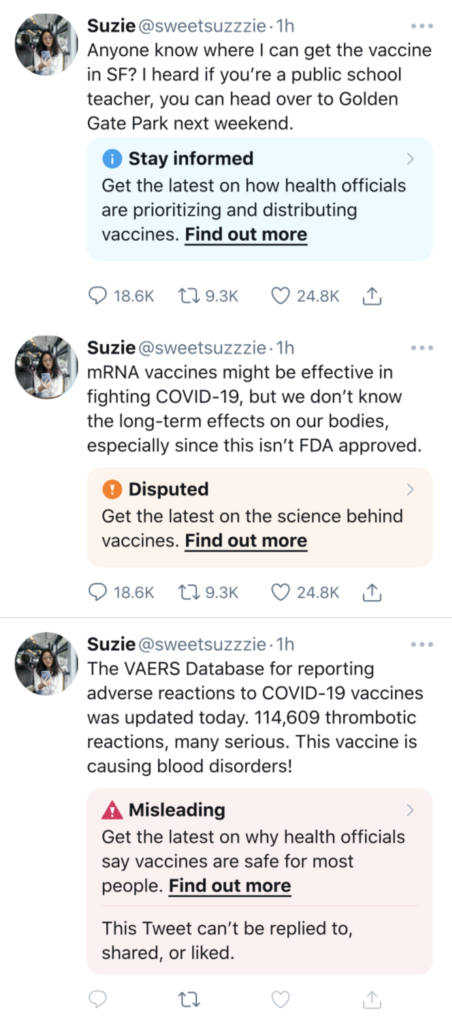
We’re looking to do a redesign of our labeling system for misinformation and we wanted to have three levels of severity: “Stay informed,” “Disputed,” and then “Misleading.” And I was just really surprised. I found out that across the board — and we tested with Democrats and Republicans — everyone found “Disputed” confusing.
So across the board, that’s a term that we’ve taken out and we’re going to test with some new terms now, because what we want is for everybody to feel included.
“Stay informed” works well. With “Misleading,” we tested that as well, and even though everybody felt like that was a bit harsh, it was very clear. So that’s probably one we’ll continue to use on the platform when it’s a really severe situation.
Something that surprised me. We have this scale that we prefer to write within, and it’s from functional to fun. So within Health, we’re obviously teetering more on the functional side, really explaining to people what things mean, what this means for them.
Whereas in some of our other parts of the app, we can be a little more fun and a little more jovial. And so it’s a really delicate line. It’s been really interesting seeing where that line is drawn, because if you cross it, people get really uncomfortable and it shows up in feedback. Or conversely, it shows up with more clicks to the Help Center or people don’t understand what we’re actually trying to say. So it’s been a fascinating journey to figure out what that line is and how we can make sure things are fun and functional at the same time.
One of the things we’re working on now is laying out where in the app that we can be more fun and where it needs to be more functional. And for the Health area, we don’t want to be boring, but we’ve heard time and time again from users that that’s not the place to be playful. People are either distressed or confused. But we’re working on sounding helpful, trustworthy, transparent, warm, and then probably on the top end, something along the lines of optimistic. And that’s probably as far to the playful side as we would go in the Health area.